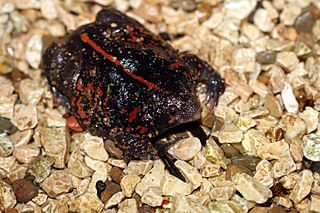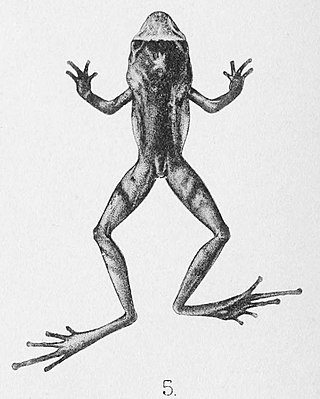
The cane toad, also known as the giant neotropical toad or marine toad, is a large, terrestrial true toad native to South and mainland Central America, but which has been introduced to various islands throughout Oceania and the Caribbean, as well as Northern Australia. It is a member of the genus Rhinella, which includes many true toad species found throughout Central and South America, but it was formerly assigned to the genus Bufo.

A frog is any member of a diverse and largely carnivorous group of short-bodied, tailless amphibians composing the order Anura. The oldest fossil "proto-frog" Triadobatrachus is known from the Early Triassic of Madagascar, but molecular clock dating suggests their split from other amphibians may extend further back to the Permian, 265 million years ago. Frogs are widely distributed, ranging from the tropics to subarctic regions, but the greatest concentration of species diversity is in tropical rainforest. Frogs account for around 88% of extant amphibian species. They are also one of the five most diverse vertebrate orders. Warty frog species tend to be called toads, but the distinction between frogs and toads is informal, not from taxonomy or evolutionary history.

Bufo is a genus of true toads in the amphibian family Bufonidae. As traditionally defined, it was a wastebasket genus containing a large number of toads from much of the world but following taxonomic reviews most of these have been moved to other genera, leaving only seventeen extant species from Europe, northern Africa and Asia in this genus, including the well-known common toad. Some of the genera that contain species formerly placed in Bufo are Anaxyrus, Bufotes, Duttaphrynus, Epidalea and Rhinella.

The common toad, European toad, or in Anglophone parts of Europe, simply the toad, is a toad found throughout most of Europe, in the western part of North Asia, and in a small portion of Northwest Africa. It is one of a group of closely related animals that are descended from a common ancestral line of toads and which form a species complex. The toad is an inconspicuous animal as it usually lies hidden during the day. It becomes active at dusk and spends the night hunting for the invertebrates on which it feeds. It moves with a slow, ungainly walk or short jumps, and has greyish-brown skin covered with wart-like lumps.

The Mexican burrowing toad is the single living representative of the family Rhinophrynidae. It is a unique species in its taxonomy and morphology, with special adaptations to assist them in digging burrows where they spend most of their time. These adaptations include a small pointed snout and face, keratinized structures and a lack of webbing on front limbs, and specialized tongue morphology to assist in feeding on ants and termites underground. The body is nearly equal in width and length. It is a dark brown to black color with a red-orange stripe on its back along with splotches of color on its body. The generic name Rhinophrynus means 'nose-toad', from rhino- (ῥῑνο-), the combining form of the Ancient Greek rhis and phrunē.
Werneria, also known as the torrent toads or smalltongue toads, is a small genus of "true toads", family Bufonidae. They are found in western Central Africa, with the greatest species richness in the Western High Plateau of Cameroon. The species generally have restricted or patchy distributions and are considered threatened.
Sclerophrys taiensis is a species of toad in the family Bufonidae. It is known from the Taï National Park in southwestern Ivory Coast and from the Gola Forest in southeastern Sierra Leone; it is likely that its range extends into the adjacent Liberia. Common name Tai toad has been proposed for it.
Nectophrynoides wendyae, also known as the Uzungwe Scarp tree toad or Wendy's forest toad, is a terrestrial toad in the family Bufonidae. It is endemic to Tanzania and is only known from a single valley in the Udzungwa Mountains. The specific name wendyae honours Wendy Clarke, the describer's wife.
Bufoides is a small genus of true toads, family Bufonidae. The genus is endemic to Northeast India, with one species known from the Garo and Khasi Hills.
Bufoides kempi is a species of true toad, family Bufonidae. This poorly known species is endemic to Meghalaya, Northeast India. It is only known with certainty from its type series collected "above Tura" at 2,500 ft (760 m) in the Garo Hills no later than 1919; there is also a possible record collected at around 2009. Its common names are Kemp's Asian tree toad, Garo Hills toad, and Garo Hills tree toad. The specific name kempi honours Stanley Wells Kemp, an English zoologist and anthropologist.

Rhinella jimi is a species of toads in the family Bufonidae. It is endemic to northeastern Brazil and known between Bujaru in northeastern Pará and Maranhão in the north, south to Bahia and Vitória, Espírito Santo. Prior to its description in 2002, it was confused with Rhinella schneideri. The specific name jimi honors Jorge Jim, a Brazilian herpetologist. Common name Jimi's toad has been coined for it.
Sclerophrys tuberosa is a species of toad in the family Bufonidae. It is found in southeastern Nigeria, Cameroon, southwestern Central African Republic, Equatorial Guinea, Gabon, and northern Democratic Republic of the Congo and Republic of the Congo. Common names rough toad, warty toad, and Fernando Po toad have been proposed for it.
Sclerophrys urunguensis is a species of toad in the family Bufonidae. It is found in the border area of Tanzania and Zambia, near the southeastern corner of Lake Tanganyika. One recent Tanzanian record is from close to the border with Burundi. Morphological characters suggests that it actually belongs to the genus Poyntonophrynus, but the formal move to that genus has not been made. Common name Urungu toad has been coined for it.

The savannah forest tree frog or ground tree frog is a species of frog in the family Arthroleptidae. It occurs in West and Middle Africa. The relationship of this species with Leptopelis bocagei is not fully settled.

The northern spadefoot toad is a species of frog in the family Limnodynastidae.

The desert spadefoot toad is a species of frog in the family Limnodynastidae. It is endemic to Australia. Its natural habitats are subtropical or tropical dry shrubland, subtropical or tropical dry lowland grassland, intermittent freshwater marshes, hot deserts, and temperate desert.

Philautus kempii is a species of frog in the family Rhacophoridae. It is known with certainty from its type locality, Upper Rotung in Arunachal Pradesh, Northeast India, in the area also claimed by China. It is also reported from Arunachal Pradesh in general as well as from extreme eastern Tibet; these might represent another species. Very little is known about this species, and even its taxonomic validity remains uncertain.

Blaira is a small genus of true toads endemic to the southern Western Ghats, India. The genus was erected in 2021 as a valid substitute name for Ghatophryne which was created in 2009 for Ansonia ornata which was found to be distinct enough to warrant its own genus. This was however considered an invalid description as it was published in an only a digital medium ; Ansonia rubigina was moved based on its morphological similarity and distribution.

Scutiger spinosus is a species of toad in the family Megophryidae. It is found in Medog County, Tibet (China) and in Tawang district, Arunachal Pradesh (India). Prior to its description in 2016, it was confused with Scutiger nyingchiensis. Common name spiny lazy toad has been coined for it.
Scutiger wuguanfui is a species of toad in the family Megophryidae. It is endemic to Tibet and only known from its type locality in the Medog County. The specific name wuguanfui honours Wu Guanfu, a Chinese herpetologist. Common names Wu's lazy toad, Medog lazy toad and Medog cat-eyed toad have been coined for it.

















